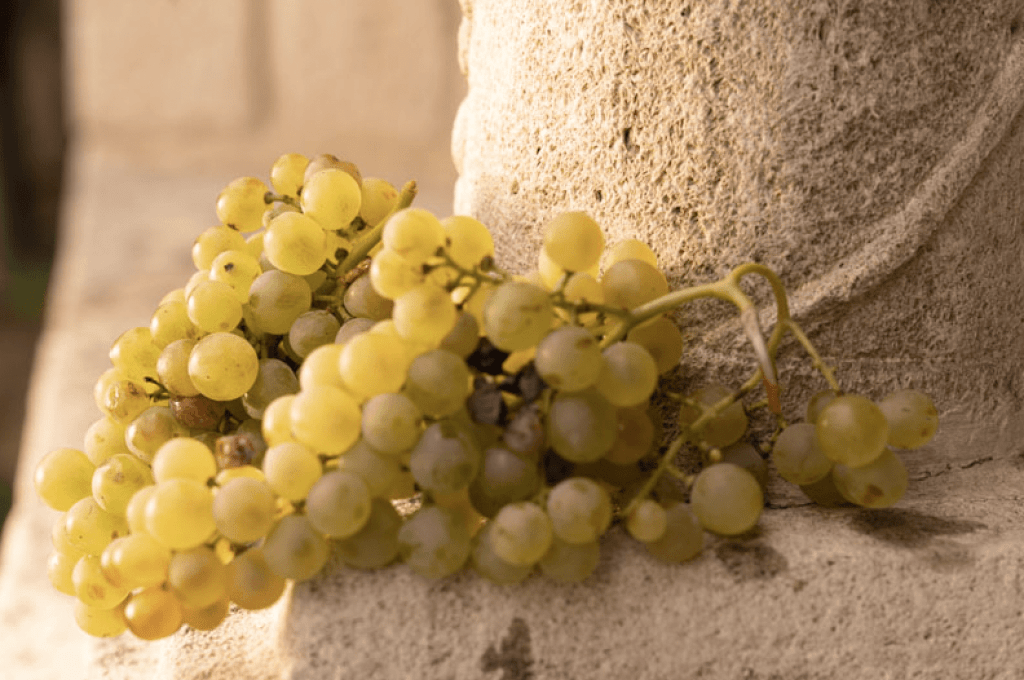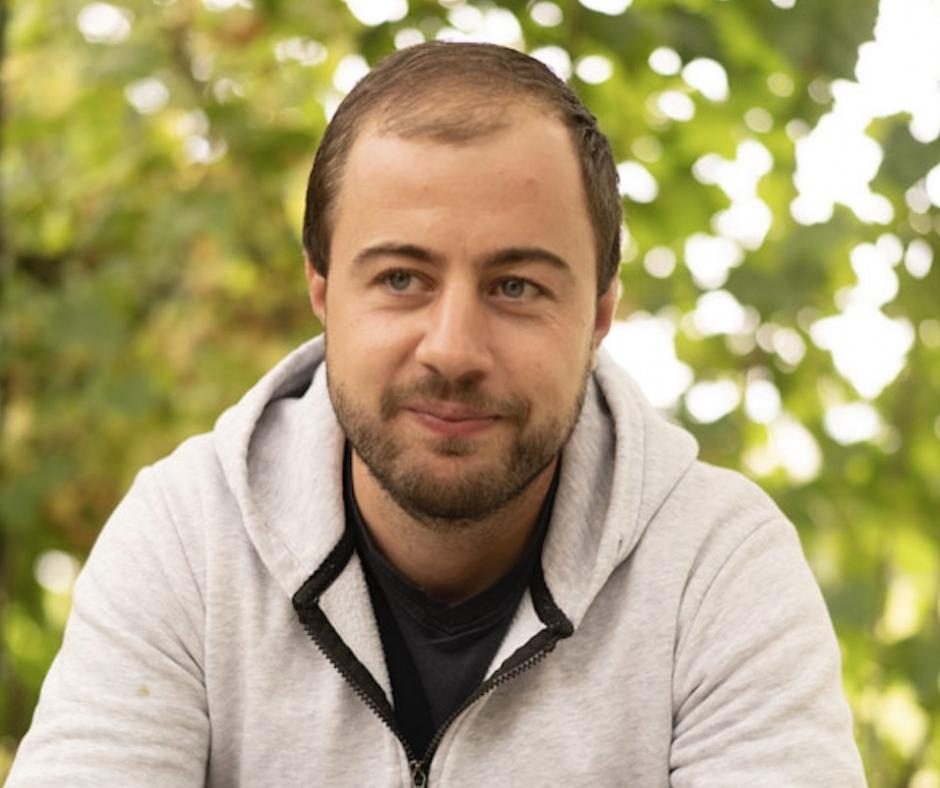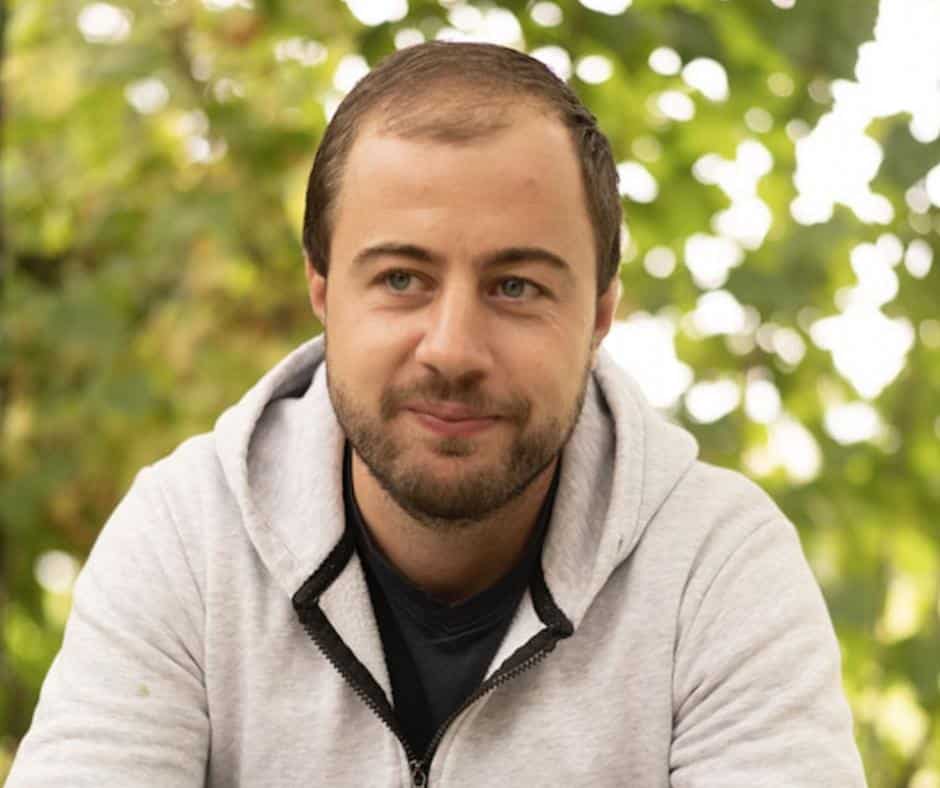At the stone table (which seems to have been there for centuries as a silent witness to the life of the winery), at dusk, after an exhausting day of harvesting, Cornel Banita, together with his colleagues, plans the next day in the vineyard. You can feel his love for "making wine". I "saw" him as a young knight who will write a part of history.
Cornel Banita – born in a family with tradition and passion for wine, "growing up among the Feteasca alba and Merlot rows", a young man slightly aged before time, as he himself jokes, with humble speech and carefully chosen words.
A man of inner strength, in whose voice one feels calm, and peace of mind, even in the midst of the "storm" of the harvesting campaign.
He doesn’t forget where he came from, grateful for all those he learned from, knowing exactly what he wants to leave behind.
At the stone table (which seems to have been there for centuries as a silent witness to the life of the winery), at dusk, after an exhausting day of harvesting, Cornel Banita, together with his colleagues, plans the next day in the vineyard. You can feel his love for "making wine". I "saw" him as a young knight who will write a part of history.
The beginnings at the famous Pietroasa Wine & Grapevine Research Station were tough, Cornel felt that the technology was missing and that this aspect had to be compensated for somehow, especially to compete with large producers who had already accessed European funds. The wine made there had to be able to sit at the same table with the wines of other producers, and he did not have a solid company behind him.
In 2-3 years he managed to have a winemaking line, a bottling line, he rebuilt all the wine ageing areas and brought almost everything he needed to be able to compete with the other producers. He wants to produce good wines both for Pietroasa and as his personal goal: for the wines to bear his signature and be representative of the area in which he works.
What are the differences between the wine you made at home, in the family, the one you made in the beginning at Pietroasa, the wine you made after finishing your studies and the one you make now?
The differences are huge, I started from an old barrel from my grandfather, with very good grapes, that’s right, because the parents took care very carefully of the inherited vineyard.
I started to see the problems for the first time, I spoiled quite a few wines at home, even my father got angry with me, because I was trying to do something new or I was forgetting something, or I wasn’t making the best decisions. Until I arrived here, where I received a rather big responsibility, somewhere over 1000 tons that I had to vinify in the first solid campaign, and the emotions were huge, very difficult to describe.
One step at a time, with the help of colleagues, with the help of equipment, teachers, friends and other winemakers that I have "nagged" over time. I have managed to obtain quite good results since the first year. This is because the grapes also helped us, always when you have a good raw material, you can juggle. But the transition was somewhat brutal, sudden and fast.
Why are so many varieties in the "ampelographic collections" of research stations, instead of being planted by those who wish for almost lost Romanian grapevine varieties – Negru vartos, Iordana, GordinProblems related to D.O.C., traceability?

Somehow I think it’s all or even more problems. We were lucky because we had reconversion funds and we were able to plant only certain varieties, not all of them being eligible, regardless of what we thought about. On the other hand, in the past these varieties were not promoted at all, or the results of these varieties were not known, and so the people somehow only noticed the international varieties. There was a lot of talk about Cabernet Sauvignon, de Merlot and everyone seemed to want the same thing, who wouldn’t want Chardonnay in the plantation?
It seems that in the last period we have realised this and producers are leaning more and more towards the local varieties. Something we did here in Pietroasa, the Alb aromat grapevine variety caught on very well, it is the first to be sold out, really, the surface is relatively small, we have about 2 ha, but it caught on very well, even if the label says "dry white wine" and you don’t have much information unless you look for it on our website. It’s something new.
What do Romanian producers do well and what do they not do well?
It is very difficult to say because it is from their own kitchen and there are so many variables. It would be very easy to judge the fact that some put a lot of emphasis on production or the commercial area, but on the other hand, if we think from an economic point of view, they might do better than someone who focuses only on having 10 bottles of top wine.
There are people who adapt to the public taste, the public is becoming more and more educated, and comes with certain demands. Demands that identify with certain producers and from here on in the vineyard, certain decisions are made in the winery, some seem to be sometimes strange, or maybe they can be very good for the financial balance. It is very difficult to say that some make mistakes and some make good decisions. The idea is for all of us to focus on quality and somehow correct the negative image that we have acquired over time in front of western clients.
Let’s take from each one all that is good, because they may also have their problems, and if we manage to pass through a correct filter, then we can advance faster than expected.
What varieties do you prefer – white, red/local, international?
Honestly everything. I try to take each variety and each wine the way it is. For example, if you found some Plavaie through our plantations, you go ahead and make wine, maybe you’ll get something ok, maybe not, but you take it for what it is.
If you see a Feteasca alba orregala you must appreciate the way that wine is and further compare it with what others have done. Of all, I think that Feteasca alba is the closest to me because I have it and have known it since I was a kid, I know its leaf very well, I know its grapes very well and, most of the times when I go in the vineyard, I tend to visit it first. I see the others later.
The next, after Feteasca alba would be Merlot (but it is not local), but it left a rather big mark on me, because I vinified it in all the possible ways, I played with it, it is so very versatile.
What are your wine-related joys?
The satisfaction is when I create the wine, I struggle and get involved so much from the first stage, from when the grapes are on the vines until the wine is in the cellar, nothing else matters… In the end, when I see the finished wine, I am less happy.
I love the process of creation, of making, more than I enjoy sitting at this stone table and saying: look, I made this wine, look how good it is, look what aroma it has! No, on the contrary, I take it and try to see all the problems that I didn’t manage to solve in the winemaking campaign so that I can start it all over again and make it different. But, mostly, when you see that your wine is appreciated, either by a knowledgeable public, by international competition, or by a simple group of visitors who come to the winery and say that it is very good – these are satisfactions that motivate you to go further.
How does one live a harvesting campaign?
During the campaign, it’s just the campaign. It usually starts on a Monday in August and probably ends on a Tuesday or Wednesday in October. It is very difficult to pay any attention to something, or someone else. Everyone is mobilised, everyone is on high alert because a lot changes from one day to the next, there are many variables from one year to the next, and many even from one day to the next. When you see that the grapes are beautiful and you don’t have anyone to harvest them with or you have too many people and you don’t know where to send them, there are moments when your heart starts beating faster, you are looking for a way to get home to rest or do something on a personal level, but the campaign is the most important moment. Although the fatigue is at a maximum level, you don’t even realise how tired you are, you also feel good, different, but good. You go on so that everything comes out fine, because the moment passes quickly and you have no other chances to make a wine from that year.
For the beginners, please tell me who and how decides/according to what, the exact moment of picking?
Climate change affects us a lot and we want to make all types of wine – having so much Tamaioasa romaneasca we vinify it in all styles. For the dry, we need to harvest this week, for the off-dry or semi-sweet, a bit later, for the cellar collection wines, we take time to harvest in November.
After we have determined what we have to do, we follow very carefully the progress of the ripening, but also the phyto-sanitary condition. This year the grapes were almost perfect until a week ago, but since the rains started, we start to see problems with grey rot. And if you decide to pick Tamaioasa next week for a certain type of wine, there is a possibility that you will have problems in being as you want because the grey rot affects the quality of the wine. And if you miss the moment, that wine will not be as you wanted it, or won’t be at all.
The moment is set in a close connection between the people at the winery and the people in the vineyard, and often decisions are made from one day to the next. At least last year, which was somewhat richer, we used to gather at this stone table in the evening and determine exactly which vessels were filled, how much we still need the next day, and the next morning we would divide into teams and gather what else was needed.
What are the legends of harvest time? Do you have superstitions and/or rituals in the area?
Legends and superstitions no, I took a lot of data collected by my colleagues here in the past. As it is this year, it was the same as in 2019 and many years ago. We didn’t really pay attention to the local legends, which started to disappear anyway.
However, I encountered a superstition or saying here in the area. It is somehow related to hygiene – it is said that you should not eat fish the night before because the smell of fish persists and can permeate the grapes that are picked and could end up in the wine. But at the winery we have many legends, there are many beautiful stories in Pietroasa.

What is the most beautiful story of the winery?
The story that I find the most interesting is about the oldest wine in our cellar, a Tamaioasa romaneasca 1942. We know well that in the first and second World Wars when we had "guests", there were all kinds of customs to destroy everything. One of these was that they would go to each barrel, knock to verify if the barrel was full or empty, and if it sounded full, they would shoot it. They drank what they drank and the rest was lost, wasted. If the barrel sounded empty, it escaped. And they managed to save only one barrel of Tamaioasa romaneascabecause they moved it in a much bigger barrel and thus, when it was knocked, it sounded hollow. This is how the only barrel Tamaioasa romaneasca of 1942 wine was preserved. Because the Station has about 50 years of history before that. That’s why I find this story interesting and beautiful, although sad at the same time.
Which oenologists or teachers do you admire/serve as an example for you?
All those who pass through our life and in my life, the family that is not related to winemaking at a high level, but knew how to motivate me to be in a certain way and to perceive things in a certain way, also all those who were by me, I mean my parents, friends, each with a special contribution, up to the teachers who guided me, the colleagues who helped me when I first arrived at the research station and all those who guided me over time, they taught me, they showed me all kinds of things, not necessarily in the scientific area. There are people who have passed through my life and left their mark and if I somehow knew how to filter that information, it meant laying a brick. Of course, I am inspired by many people from winemaking, vine growing, and wine marketing, but I tried to take all the good parts from everyone and change them somehow in my own style, to modify them so that they are my own, personal, and different. I try to take a bit from each one, from home and from work and put everything in a pyramid so that something beautiful comes out at the end.



